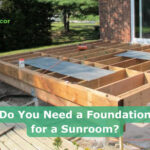Sunrooms are architectural marvels, transforming homes with an infusion of natural light, temperature control, and expanded living spaces. If you’re considering this radiant addition to your home, a crucial question emerges: How long do sunrooms last?
In this comprehensive guide, we delve into the lifespan of sunrooms, factors influencing longevity, and strategies for maintenance and upgrades to ensure your sun-soaked haven stands the test of time.
How Long Do Sunrooms Last?
The Lifespan Spectrum: From Kits to Integrated Additions
The longevity of a sunroom hinges on various factors, including its type, construction, materials, and maintenance. Prefabricated sunroom kits, designed for quick assembly, typically last between 10 to 20 years. These DIY-friendly options prioritize affordability but sacrifice longevity.
On the other end of the spectrum, sunroom additions integrated into the home’s structure boast an extended lifespan, easily surpassing 50 years with proper care. The quality of materials, construction, and foundation play pivotal roles in determining a sunroom’s durability.
- Prefabricated Sunroom Kits: 10 to 20 years
- Integrated Sunroom Additions: 50+ years
Factors Influencing Lifespan: Quality, Design, and Maintenance
- Quality of Materials: The type and quality of materials used significantly impact a sunroom’s lifespan. Investing in durable materials contributes to long-term resilience.
- Design and Construction: Integrated sunroom additions, designed to match the existing structure, tend to outlast prefabricated kits. The integration and foundation strength enhance longevity.
- Three-Season vs. Four-Season Sunrooms: The purpose and design influence lifespan. Three-season sunrooms, not equipped for winter use, last longer than prefabricated kits but less than four-season sunrooms.
- Regular Maintenance: Regardless of type, regular maintenance is the key to maximizing a sunroom’s lifespan. Cleaning, inspections, and immediate repairs ensure sustained durability.
Combatting Mold in Sunroom
Mold in sunrooms often stems from excess moisture and inadequate ventilation. Key contributors include poor sealing, insulation gaps, and insufficient waterproofing. Understanding the causes is crucial for effective prevention.
Contributors to Mold Growth:
- Excess Moisture: High humidity levels without proper ventilation create an ideal environment for mold.
- Sealing and Insulation Issues: Poorly sealed windows, doors, and insufficient insulation contribute to moisture infiltration.
- Water Accumulation: Rainwater leaks, condensation, and inadequate waterproofing allow moisture to accumulate, fostering mold growth.
Preventing Mold Growth:
- Humidity Control: Maintain optimal humidity levels within the sunroom through ventilation and dehumidifiers.
- Proper Sealing: Ensure windows and doors are well-sealed to prevent water intrusion.
- Effective Insulation: Adequate insulation prevents condensation, reducing the risk of mold.
- Regular Inspections: Periodic checks for leaks, sealing issues, and waterproofing ensure early detection and prevention.
Leak Prevention
Leaking sunrooms are not inherent; rather, they result from construction flaws, material choices, and insufficient maintenance. While prefabricated sunroom kits are more prone to leaks, proper construction and regular upkeep mitigate this risk.
Factors Contributing to Leaks:
- Window Installation: Prefabricated kits lack weatherproofing, making them susceptible to leaks. Integrated sunroom additions with flanges and weatherproofing are less prone.
- Design Flaws: Poorly designed intersections with the main structure or improper installation can lead to leaks.
- Roof and Gutter Maintenance: Regular inspection and cleaning of the sunroom roof and gutter system prevent blockages that may cause leaks.
Preventing Leaks:
- Quality Installation: Proper installation, especially around windows and main structure connections, is essential.
- Regular Maintenance: Scheduled checks, seal replacements, and gutter clearing are vital for preventing leaks.
- Foundation Integrity: Ensure the sunroom’s foundation and structure remain sound to prevent gaps and potential water entry.
Upgrading Your Sunroom
While a well-designed sunroom is a timeless delight, embracing upgrades ensures it stays abreast of evolving technologies and trends. From advanced glazing options to energy-efficient doors and roofing materials, the possibilities for sunroom transformation are limitless.
Potential Upgrades:
- Advanced Glazing: Explore the latest innovations in glass technology to enhance insulation and energy efficiency.
- Energy-Efficient Doors: Upgrade to doors with superior insulation properties, minimizing heat loss and maximizing comfort.
- Roofing Materials: Consider modern roofing materials that offer improved durability and weather resistance.
- Exterior Refinements: Explore options like new rendering or exterior finishes to revitalize your sunroom’s aesthetics.
Long-Term Value Enhancement
A well-maintained and upgraded sunroom not only stands the test of time but also contributes to long-term property value. While updates may be sporadic, even a decade-old sunroom can be revitalized with contemporary enhancements, making it a valuable asset during resale.
Conclusion
As you embark on the sunroom journey, envisioning a space flooded with natural light and tranquility, remember that longevity is a result of thoughtful design, meticulous maintenance, and occasional upgrades. Your sunroom, whether a cozy reading nook or an entertainment hub, is a testament to the enduring beauty of architectural ingenuity. Nurture it, embrace innovations, and let your sun-soaked haven evolve gracefully, radiating warmth for generations to come.



